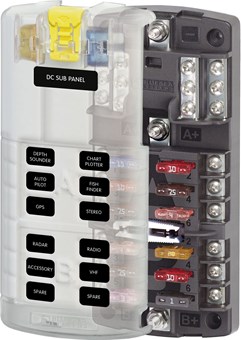Rumored Buzz on Blue Sea Fuse Block
Wiki Article
Some Known Factual Statements About Blue Sea Fuse Block
Table of ContentsBlue Sea Fuse Block - TruthsSee This Report on Blue Sea Fuse BlockThe Only Guide to Blue Sea Fuse BlockAn Unbiased View of Blue Sea Fuse BlockBlue Sea Fuse Block for Beginners
If the current exceeds the AIC level, the tool may arc throughout or form a few other conductive course, and fail to do its job. The ABYC requires a/c and also DC circuit breakers to have a minimal AIC rating of 3,000 amps in many conditions, and also 5,000 amps in some.These are commonly available as well as not that expensive. The current-carrying capability of conductors is given up numerous tables. These are utilized to determine the optimum breaker or fuse ranking (you can constantly go lower). In the American Watercraft & Luxury Yacht Council (ABYC) table, for an offered conductor size (e.


Some Known Details About Blue Sea Fuse Block
g., 00, generally written as 2/0, or 000, composed as 3/0, and more). The European system simply determines the size, or cross-sectional location, of the copper in a conductor as well as utilizes that. Not only are united state wire sizes counterintuitive, but there are also 2 different conductor-sizing formulas using the very same numbering system.

To deal with this situation, the higher the number of conductors in a bundle, the much more the current-carrying capability (ampacity) of the specific conductors is de-rated. This is done by applying a de-rating element. Till recently the ABYC applied this de-rating of packed conductors only to circuits lugging more than 60V, which in functional boating applications implies air conditioner circuits, yet the ABYC currently also partially uses de-rating to DC circuits.
Examine This Report on Blue Sea Fuse Block
You can discover a PDF version of these tables and also a description on exactly how to utilize them right here. A coiled shore-power cable sitting in the sun is one instance not covered by packing and also various other guidelines for which a wire ought to still be derated as a result of high temperature. The combined impacts of the coiling (effectively, a kind of packing) as well as solar heating can properly derate a shore-power cord by as much as 50%.A conductor ought to be derated whenever there is any kind of blockage to dissipating the warm generated within it. Note that many cabling utilized in U.S.-built boats has an insulation temperature score of 105C/221F, as opposed to the 90C/194F or also 60C/140F cabling located in numerous European-built boats. The insulation temperature score need to be published on the cord, and if it is not, the cable television does not adhere to ABYC next page requirements.
As kept in mind a fantastic read above, in some conditions a lower conductor insulation ranking may be picked. If any kind of component of the circuit being safeguarded is inside an engineroom, the Inside Engine Spaces sub-column is made use of to determine the optimum permitted OCP, but or else, the Outside Engine Spaces sub-column is pertinent (blue sea fuse block). If the conductor is in a package, use the ideal de-rating aspect based upon the variety of conductors in that package.
The Facts About Blue Sea Fuse Block Uncovered
If there is no exact match between the resulting conductor ampacity as well as readily available fuse or breaker rankings, the ABYC requirements permit the following highest possible ranked fuse or breaker to be made use of on almost major circulation panel merges and also breakers (these can not exceed 100% of the circuit score), as long as the fuse or breaker's score does not surpass 150% of the ampacity of the conductor it is protecting.Breaker need to match the ampacity of the cable televisions they are safeguarding! Identify whether a fuse or a circuit breaker is a lot more appropriate for the task. Determine the ampacity redirected here of the smallest conductor to be shielded by the overcurrent tool. Identify the optimum continuous existing that will move on the circuit.
In some cases, especially with bilge pumps, there is a lengthy run of partially sized circuitry to the motor (blue sea fuse block). If a locked-rotor problem creates, the overall resistance in the circuit may suffice to restrict the current circulation to a level that will not trip the breaker or blow the fuse however which nevertheless is high enough gradually to begin a fire at the pump.
Unknown Facts About Blue Sea Fuse Block
The conductor size have to be increased so that the voltage decrease on the circuit is lowered to a level at which enough present to trip the breaker or blow the fuse can flow. In any kind of event, the ABYC needs that all electric motors and electric motor circuits be created and also secured so that they can stand up to a locked-rotor condition for 7 hours without developing a fire danger.Reasonably economical as well as portable breakers rated at up to 150 amps are currently widely offered, together with economical, small fuses up to 800 amps. Typical amperage rankings for usual aquatic fuse types.
The neatest means to take care of them, as well as provide the essential overcurrent protection, is to run a solitary hefty conductor, typically 2/0 gauge (70mm), from the favorable blog post on the home batteries to a battery-isolation switch. This conductor must be effectively integrated as close to the battery as possible. If the conductor is bolted (instead of secured) to the battery blog post, there are purpose-built integrates that can be added at the battery blog post itself (MRBF integrates).
Report this wiki page